|
|
| Home - Software M&A Review - Jul 04 Issue |
Software M&A - A Glimpse into the Second Quarter
continued... page 2 |
Only one in ten buyers proved more adventurous in 2Q04, with just a handful of buyers willing to acquire their way into a new vertical market (3%), new geography (2%), or a new software product category (6%). Examples include Cyberguard's acquisition of German security solutions provider Webwasher; Compuware's acquisition of IT governance software developer Changepoint; and Fair Isaac's acquisition if UK-based banking software provider London Bridge. The current dearth of new market/new category deals represents a significant retrenchment in buyer thinking. In 4Q03, these new market / new category buyers comprised almost 20% of all acquisitions.
2. Heightened activity. The number of software transactions has increased quarter-over-quarter for the past nine months and the software M&A market is gaining momentum. Software company buyers, buoyed by increased IT spending, solid revenue growth and improved profitability, are once again acquisition minded. We reaffirm our January forecast of a 10% year-over-year increase in transactions for 2004, but the number could go considerably higher. Gating factors include concerns about the economy enumerated earlier and the current refusal of most buyers to acquire outside their comfort zone. Consider, also, there are simply fewer buyers today than four years ago as a result of continuing industry consolidation, the demise of many Bubble Era public software companies and far fewer software IPOs. For the first time in a long time, demand has outstripped supply, but only for companies with technologies, products and markets deemed highly strategic by acquirers.
3. For the chosen, high valuations. When buyers do fall in love, however, money is no object. The median software company M&A valuation (based on
equity purchase price), reached 2.9 times trailing-twelve-months (TTM) revenue in 2Q04, more than double the median M&A valuation one year ago, and a noteworthy improvement over 1Q04's 2.3x (Figure 11). In a move reminiscent of the Bubble Era, Symantec acquired Brightmail, which had filed an initial public offering registration statement, for an amount roughly equivalent to (some believe greater than) the anticipated IPO net proceeds. Though few transactions could match the 14.2x multiple Symantec paid for Brightmail, Mercury Interactive came close in acquiring Appilog for $49 million, which we estimate represents a 12x multiple. Other transactions apparently deemed truly strategic by the buyer included Compuware's acquisition of Changepoint (5x); BMC's acquisition of Marimba (4.6x); and SteelCloud's acquisition of V-One (4x).
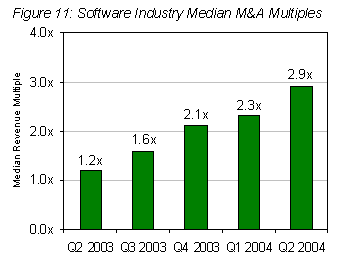
There were fewer industry consolidation plays in 2Q04 than the previous quarter, but that may change shortly. The Oracle vs. Justice Department trial in San Francisco is providing a unique opportunity to observe the world's largest software providers as they formulate backroom strategy. Each seeks to increase the control it exercises over enterprise customers by aggressively expanding its platform to broadly encompass both applications and infrastructure. Microsoft, fearful that rival IBM would acquire SAP if Oracle was successful in taking over Peoplesoft, a key IBM's business partner, is apparently considering a possible run at Peoplesoft itself, after giving some thought to acquiring SAP. Undaunted by the backlash from its Peoplesoft takeover attempt, Oracle also appears interested in such "potential targets" as BEA Systems, Business Objects, Siebel and Lawson. In response, IBM has expressed
interest in gaining more control over the software sector, either by direct investment in the likes of Peoplesoft or through outright acquisitions. It's beginning to sound like a Tom Clancy novel.
Industry consolidation is practically a law of nature. However our somewhat contrarian view is that consolidation among the industry's largest players will not occur on the scale many predict. The largest enterprise, government and institutional customers, still smarting from huge ERP and CRM investments which did not yield the anticipated ROI, will vigorously resist being dominated by a few players that control both applications and infrastructure. Other negating factors include clashing egos, reluctant Boards, relatively high current valuations, the prospect of massive layoffs and a historically poor track record for industry mega-mergers.
Always interesting is the ebb and flow of M&A activity among different software product categories. There was a flurry of activity in enterprise resource planning. Customer relationship management software companies were also popular targets, accounting for 9% of all 2Q04 software M&A activity (Figure 12). Business technology optimization (a subcategory of enterprise system management) was a "must have" for many of the leading tools and infrastructure players, with 5 deals this quarter. IBM bought BMC competitor Candle Corp. for an estimated $475 million prompting BMC to respond by acquiring Marimba, not a month later, for $186 million. Business process management (a/k/a business activity monitoring or business performance measurement), is also attracting attention from buyout firms and business intelligence software providers. We counted 2 deals in this space during the quarter (Onyx/Visuale and Tibco/Staffware).
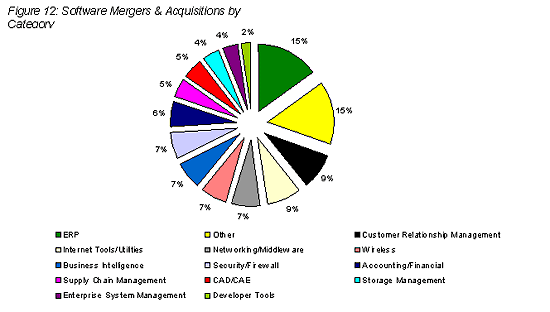
Expectedly, security software remains one of the most active acquisition arenas. An array of security software vendors were targeted and acquired in 2Q04, including Brightmail/Symantec, Webwasher/Cyberguard, V-One/SteelCloud, Magnifire/F5 Networks and Trio Security/Symbol Technologies.
MERGERS AND ACQUISITIONS: THE NUMBERS
U.S. merger and acquisition activity in the second quarter of 2004 showed improvement over the equivalent quarter a year ago, and exit valuations continued to ramp. Domestic M&A activity in 2Q04 across all industry sectors totaled 2,517 deals aggregating $153 billion (Figure 13). Relative to 2Q03, the number of deals increased by 18%, while total dollars spent increased 39% over the same period. At the current run rate, 9,980 deals aggregating $769 billion will close in 2004.
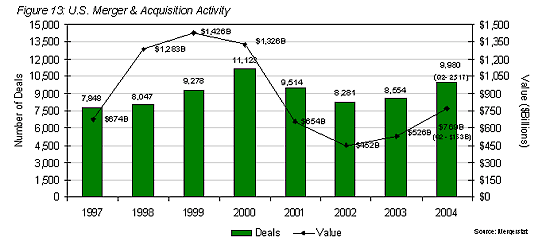
Software continued to lead all other industries with 425 transactions, representing approximately 17% of all U.S. M&A activity this quarter (Figure 14). Acquirers spent $8 billion on software businesses in 2Q04, seemingly a precipitous decline in M&A dollar volume when compared to the $15.4 billion recorded in 2Q03. But with no mega-deals (> $1 billion) in 2Q04 and 3 mega-deals in 2Q03 totaling $12.7 billion, it's clear substantially more dollars are being spread across a significantly greater number of transactions. Median software company exit valuations have now increased quarter-over-quarter for six consecutive quarters. The median software company M&A valuation (based on equity purchase price), reached 2.9 times trailing-twelve-months
(TTM) revenue in 2Q04, more than double the median M&A valuation of one year ago, and a noteworthy improvement over 1Q04's 2.3x (Figure 11).
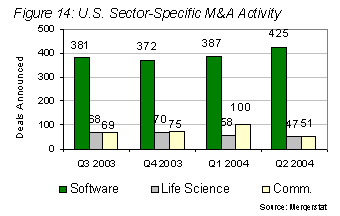
With stock prices giving up little of their 2003 gains, stock continued to be a popular form of deal currency. Public companies appeared eager to use their higher priced stock to finance acquisitions, and sellers saw sufficient upside to gamble. As a result, stock comprised all or part of the deal consideration in 58% of 2Q04 transactions, as contrasted with 33% of buyers who took stock in 2Q03. Stock-only deals comprised 26% of 2Q04 transactions, compared to 22% in 1Q04 and 18% in 2Q03 (Figure 15).
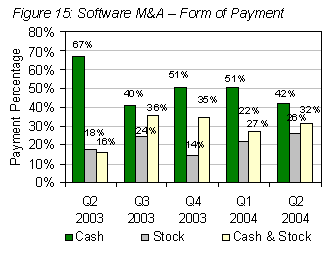
MERGERS AND ACQUISITIONS: MOST ACTIVE BUYERS
Multi-transaction buyers proliferated in the first quarter, but decreased in the second quarter of 2004. Some of the quarter's most active buyers:
Autobytel.com
C-COR.net
IBSG International
IBM
- Candle
- Schlumberger (Business Unit)
Mentor Graphics
- 0-In Design Automation
- Atair GmbH
Procera Networks
Sybase
Workstream
- Kadiri
- PeopleView (HCM Tools division)
This report was prepared by Software Equity Group, L.L.C. (SEG), a mergers and acquisitions advisory firm serving the software, life science and technology sectors. SEG is solely responsible for its content. This material is based on data obtained from sources we deem to be reliable; it is not guaranteed as to its accuracy and does not purport to be complete. This information is not to be used as the primary basis of investment decisions. For more, please visit www.softwareequity.com, or phone (858) 509-2800.
 

|
|


|

